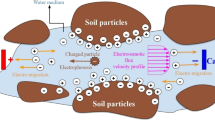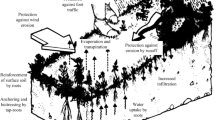Abstract
A number of remediation technology have developed and available for the remediation of contaminated ground. Although many established technology used ground decontamination, complete remediation of fine-grained soil is impossible with conventional technology. Therefore, emerging electrokinetic technology could be feasible techniques. For the application of electrokinetic technology, however, should overcome some limitations. Enhanced electrokinetic technology, hybrid and combined technology make possible overcoming limitations. In this research, for the practical remedial action by electrokinetic technology, a remedial selection flow chart and eight conceptual models with five soil types were suggested.
Similar content being viewed by others
References
Acar, Y.B., Alshawabkeh, A.N. and Gale, R.J., 1992, A review of fundamentals of removing contaminants from soils by electrokineticsoil processing. Environmental Geotechnology, Proceedings of the Mediterranean Conference on Environmental Geotechnology, Balkema, Rotterrdam, 321–330.
Acar, Y.B. and Alshawabkeh, A.N., 1993, Principles of electrokinetic remediation. Environmental Science & Technology, 27, 2638–2647.
Acar, Y.B. and Alshawabkeh, A.N., 1996, Electrokinetic remediation. 1: Pilot-scale tests with lead spiked kaolinite. Journal of Geotechnical and Geoenvironmental Engineering, ASCE, 122, 173–185.
Acar, Y.B., Hamed, J.T., Alshawabkeh, A.N. and Gale, R.J., 1994, Removal of cadmium(II) from saturated kaolinite by the application of electrical current. Geotechnique, 44, 239–254.
Acar, Y.B., Rabbi, M.F. and Ozsu, E.E., 1997, Electrokinetic injection of ammonium and sulfate ions into sand and kaolinite beds. Journal of Geotechnical and Geoenvironmental Engineering, 123, 239–249.
Alshawabkeh, A.N. and Acar, Y.B., 1992, Removal of contaminants from soil by electrokinetics: A theoretical treatise. Journal of Environmental Science and Health, A27, 1835–1861.
Alshawabkeh, A.N. and Yeung, A.T. and Bricka, M.R., 1999, Practical Aspects of In-Situ Electrokinetic Extraction. Journal of Environmental Engineering, ASCE, 125, 27–35.
Bruell, C., Segal, B. and Walsh, H., 1992, Electro-osmotic removal of gasoline hydrocarbons and TCE from clay. Journal of Environmental Engineering, ASCE, 118, 68–83.
Cauwenberghe, L.V., 1997, Technology overview Report: Electrokinetics. Ground-water Remediation Technologies Analysis Center, Pittsburgh, p. 6–7.
Elektorowicz, M. and Boeva, V., 1996, Electrokinetic supply of nutrients in soil bioremediation. Journal of Environmental Technology, 17, 1333–1349.
Esrig, M.I. and Gemeinhardt, J.P., 1967, Electrokinetic stabilization of an illitic clay. Journal of the Soil Mechanics and Foundations Division, ASCE, 93, SM3, 109–128.
Fleureau, J.M. and Kheirbek-Saoud, S., 1996, Depollution of oil contaminated soil by electro injection. Environmental Geotechnics, Proceedings of The Second International Congress on Environmental Geotechnics, Osaka, Japan, 5–8, Feb., 999–1004.
Fountain, J.C., 1998, Technologies for Dense Nonaqueous Phase Liquid Source Zone Remediation. GWRTAC, Technology Evaluation Report, TE-98-02.
Hamed, J., Acar, Y.B. and Gale, R.J., 1991, Pb(II) removal from kaolinite by electrokinetics. Journal of Geotechnical Engineering, ASCE, 117, 240–271.
Han, S.J., 2000, Characteristics of electroosmosis and heavy metal migration in contaminated soil by electrokinetic technique. Ph. D. dissertation, Chung-Ang University, Seoul.
Ho. Sa V, Athmer, C.P., Sheridan, W.B. and Shapiro, A., 1997, Scale-up aspects of the Lasagna™ process for in situ soil decontamination. Journal of Hazardous Materials, 55, 39–60.
Ho. Sa V, Athmer, C.P., Sheridan, W.B., Hughes, M., Orth, R., Mckenzie, D., Brodsky, P., Shapiro, A., Thornton, R., Salvo, J., Schultz, D., Landis, R., Griffith, R. and Shoemaker, S., 1999a The Lasagan Technology for In Situ Soil Remediation. 1. Small Field Test. Environmental Science & Technology, 33, 1086–1091.
Ho. Sa V, Athmer, C.P., Sheridan, W., Hughes, B.M., Orth, R., McKenzie, D. Brodsky, P., Shapiro, A., Sivavec, T.M., Salvo, J., Schultz, D., Landis, R., Griffith, R. and Shoemaker, S., 1999b, The Lasagan Technology for In Situ Soil Remediation. 2. Largel Field Test. Environmental Science & Technology, 33, 1092–1099.
Hyman, M. and Bagaasen, L., 1997, Select a Site Cleanup Technology. Chemical Engineering Progress, 93, 22–43.
Johnson, P.C., Stanley, C.C., Kemblowski, M.W., Byers, D.L. and Colthart, J.D., 1990, A practical approach to the design, operation, and monitoring of in situ soil-venting systems. Ground Water Monitoring Review, 10, 159–178.
Lageman, R., Pool, W. and Seffinga, G.A., 1989, Electro-reclamation in theory and practice. Forum on Innovative Hazardous Waste Treatment Technologies, EPA/540/2-89/056, p. 57–76.
Lee, C.H., 2000, Site assessment and in situ remediation technology application for contaminated sites. Ph.D. dissertation, Seoul National University, Seoul.
Leitão, T.E., 1996, Methodologias para a Reabilitação de Aquíferos Poluídos. Ph.D. dissertation, Lisbon Faculty of Science, Lisbon, 489 p.
Monsanto Company, 1998, Rapid commercialization Initiative (RCI) Final Report for an Integrated In-Situ Remediation Technology (Lasagna™). Monsanto Company.
Otten, A., Alphenaar, A., Pijls, C., Spuij, F. and Han De Wit, 1997, In Situ Soil Remediation. Kluwer Academic Publishers, Dordrecht, The Netherlands, p. 45–58.
Penn, M., Savvidou, C. and Hellawell, E.E., 1996, Centrifuge modelling of the removal of heavy metal pollutants using electrokinetics. Environmental Geotechnics, proceedings of The Second International Congress on Environmental Geotechnics, Osaka, Japan, 5–8, Feb., 1055–1060.
Rødsand, T. and Acar, Y.B., 1995, Electrokinetic extraction of lead from spiked Norwegian marine clay. 2000 Environment, Geotechnical Special Publications, 46, 1518–1563.
Roote, D.S.P.G., 1997, In Situ Flushing. GWRTAC, Technology Overview Report, TO-97-02, Pittsburgh, p. 2–6.
Sellers, K., 1999, Fundamentals of hazardous waste site remediation. Lewis Publishers.
Shapiro, A.P. and Probstein, R.F., 1993, Removal of contaminants from saturated clay by eletro-osmosis. Environmental Science & Technology, 27, 283–291.
Stewart, D.I. and West, L.J., 1996, Electrokinetic soil decontamination-effect of local resistivity variations. Environmental Geotechnics, Proceedings of The Second International Congress on Environmental Geotechnics, Osaka, Japan, 5–8, Feb., 1101–1106.
Suthersan, S.S., 1997, Remediation Engineering Design Concepts. Lewis Publishers, 94–101, 115–117.
Thevanayagam, S. and Rishindran, T., 1998, Injection of nutrient and TEAs in clayey soils using electrokinetics. Journal of Geotechnical and Geoenvironmental Engineering, ASCE, 124, 330–338.
Ugaz, D.A., 1994, Feasibility studies of radionuclide removal from kaolinite by electrokinetic soil processing. Ph.D. dissertation, Louisiana State University, Baton Rouge, L.A.
US Army Corps of Engineers, 1994, Engineering and Design, Technical Guidelines for Hazardous and Toxic Waste Treatment and Cleanup Activities. Engineer Manual (EM) 1110-1-502 US Army Corps of Engineers, Washinton, D.C., April, 4:88–4:93, 4:112–4:115.
US Army Corps of Engineers, 1995, Engineering and Design, Soil Vapor Extraction and Bioventing. Engineer Manual (EM) 1110-1-4002, US Army Corps of Engineers, Washington, D.C., 30 November, 3:1.
US EPA, 1990a, Assessing the Geochemical Fate of Deep-well-Injected Hazardous Waste. EPA/625/6-89/025a, 38.
US EPA, 1990b. Handbook on In Situ Treatment of Hazardous Waste-Contaminated Soils. EPA/540/2-90-002 (NTIS PB90-155607), 103–115.
US EPA, 1991a, Site Characterization for Subsurface Remediation. EPA/625/4-91/026, 59, 103–109.
US EPA, 1991b, Ground-Water Issue: Characterizing Soils for Hazardous Waste Site Assessments. EPA/540/4-91/003, 1–2.
US EPA, 1995, In-situ remediation technology status report; Electrokinetics. EPA/542/K/94/007, 1–7.
US EPA, 1997. Recents Developments for In Situ Treatment of Metal Contaminated Soils. EPA/542/R/97/004, 1–2.
US EPA, 1999a, Treatment Technologies for Site Cleanup: Annual Status Report (Ninth Edition). EPA/542/R-96/010, 12–17.
US EPA, 1999b, Sandia National Laboratories In Situ Electrokinetic extraction technology: Innovative Technology Evaluation Report. EPA/540/R-97/509, 1–2, 39.
US EPA, 1999c, Solidification/Stabilization Use at Superfund Sites. EPA/542/R-00/010, 1–2.
US EPA, 2000, Cost and Performance Report: Electrokinetic Extraction at the Unlined Chromic Acid Pit. Sandia National Laboratories, New Mexico, 8–9.
US EPA, 2001, Treatment Technologies for Site Cleanup: Annual Status Report (Tenth Edition). EPA/542/R-01/004, 4–5.
Wiles, C.C., 1987, A Review of Solidification/Stabilization Technology. Journal of Hazardous Materials, 14, 5–21.
Wilson, L.G., 1981, Monitoring in the vadose zone: Part I, Storage changes. Ground Water Monitoring Review 1, 32–41.
Wilson, L.G., 1982, Monitoring in the vadose zone: Part II. Ground Water Monitoring Review 2, 31–42.
Wilson, L.G., 1983, Monitoring in the vadose zone: Part III. Ground Water Monitoring Review 3, 55–166.
Wong, J.H.C., Lim, C.H. and Nolen, G.L., 1997, Design of remediation systems. Lewis publishers.
Yeung, A.T. and Datla, S., 1995, Fundamental formulation of electrokinetic extraction of contaminants from soil. Canadian Geotechnical Journal, 32, 569–583.
Yeung, A.T., Hsu, C.H. and Menon, R.M., 1996, EDTA-enhanced electrokinetic extraction of lead. Journal of Geotechnical Engineering, ASCE, 122, 666–673.
Yeung, A.T. and Mitchell, J.K., 1993, Coupled fluid, electrical and chemical flows in soil. Géotechnique, 43, 121–134.
Author information
Authors and Affiliations
Corresponding author
Rights and permissions
About this article
Cite this article
Kim, SS., Han, SJ. & Cho, YS. Electrokinetic remediation strategy considering ground strate: A review. Geosci J 6, 57–75 (2002). https://doi.org/10.1007/BF02911336
Received:
Accepted:
Issue Date:
DOI: https://doi.org/10.1007/BF02911336




